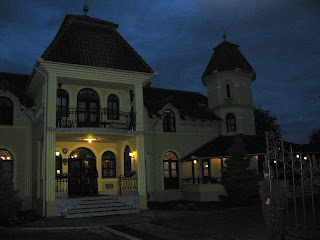Then we got to Belgrade airport which is tiny (roughly the size of Providence Airport, only way less parking, shorter security lines and about half the flights) and I saw the sweater display at the tourism store.

Why oh why didn't I take the time to go to Slatibor for some sweaters? Next year, it's top priority.
Then we are through security (GREAT uniforms gals, I especially like the epaulets.) and on our plane. I love the crews on JAT airlines, they are very serious about their jobs. I don't know why, but they feel more like Grown Ups than any other airlines' crews. I wish to use this blog as a public forum to apologize about the ipod thing to them right now. I'm sorry. It will not happen again.
JAT pilots are the most talky pilots on this planet. They get on the intercom to make that "welcome to our flight" pilot announcement and it just never ends. I have never heard so many details about our flight path, etc as with the JAT guys. Plus, of course, just like the Serbian Orthodox Priests in America they have to give every single speech twice in its entirety, once in Serb and then in English. (Which, on Easter Sunday just when you think you're coming down the home stretch of the service after standing for more than 90 minutes, and the priest switches languages and starts the entire thing over at the beginning again, can be overwhelming. This also explains why invariably somebody faints during big church services.)
Unfortunately no one who works in flight sales planning at the JAT home office has ever apparently tried to make a connection at Heathrow. The official line (as in written in official documents) "You need a hour and a half between flights to make connections" is so blatantly inaccurate as to make actual Heathrow officials giggle when you mention it to them. I know, I mentioned it to them. Yes, it's in writing, but they never expected anyone to be so naive as to believe them and base flight scheduling on this.
JAT is that naive and I, stupidly, didn't think to double check our flight plans set by the infamous Danny Travel of New York who book so many Serb immigrant flights that they answer the phone "Dobar dan" and have a hard time spelling my name but not my husband's.
Which is how we ended up in standing a Line of Serbs at the Terminal 3 help desk for JAT's partner airline Virgin Atlantic trying to get rebooked to get home somehow because we all missed our connections due to endless security lines in Terminal 2 which you are forced to go through to connect from (or to) JAT airlines and most other flights. Luckily we were able to get rebooked on a British Airways flight later in the day. Unluckily this required going back on a bus to Terminal 2 and those horrible lines yet again to get our old tickets stamped by JAT officials.
We made friends with other Serbs in line though. All agreed what Terminal 2 really needs is a little Serb cafe serving Turkish coffee to security staff and Jelen Pivo to everyone in line (the black and yellow umbrellas would match Heathrow's signage perfectly.)
We also had a fine time meeting the AirItalia service guy who mans the booth for all ticket problems for all Balkan countries as well as Italy. There's a list of central and eastern European national airline logos taped on the counter in front of him so you know he's the right guy to go to. (Hint to JAT: this is a branding and PR no-no your marketing department ought to look into. A small paper sign shared with Uzbekistan Air and 7 others does not make you look impressive. It makes you look like a little dinky country who can't even afford (or need) to have a service booth of their own. And this is the booth every single JAT passenger coming via Heathrow must go to as part of their first experience of "entering" Serbia.)
While we waited for JAT's local admin manager to come up out of the bowels of the building to stamp our tickets, he told us stories about local-based JAT staff. Although the airline is fairly small, the JAT girls (they are mostly female) are obviously larger than life characters in the Heathrow staff scene. Everyone knows them.
BTW: If you are the blonde assistant manager, I agree Heathrow Internal Security have absolutely no sense of humor. They should have understood about your shoes and then that strip tease and subsequent week-long ban would have never happened.
Finally we made it via yet more buses and security lines to Terminal 4 and hence to the sky and home again. Waiting in line at US passport control & customs, I noticed all non-US passport holders were being treated like potential criminals. Everyone was fingerprinted and photographed before being let in the country. Luckily most on our flight took it lightly, laughing. But I can imagine flights from some other countries being mightily affronted.
In a probably futile effort at placation, every US Passport Control Officer's desk has a sign posted in front giving in effect a Customer's Bill of Rights. You have the right to be politely treated and to have your questions answered. You have the right to ask to speak to a supervisor. You have the right to great customer service.
These made me remember a similar sign I'd seen posted in front of nearly every single Heathrow employee including bus drivers' seats, ticketing agents, security people's stands, even gate managers. I wish I wrote down precisely what they said, but in effect the words were, "Please do not be rude or act aggressively toward Heathrow staff. They deserve to work in an environment where people are not shouting at them all the time."
The dichotomy between these two sets of national signs -- in the US you have a right to polite customer service, in the UK the service staff have a right to polite customers -- made me smile.
And now, off to eat massive quantities of Vietnamese food. Good to be home in America where such things are possible!























